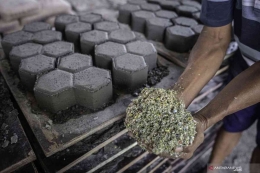After all the conditions are met, the next step is the process of making paving blocks from scrap waste, which involves certain conditions or steps to ensure a quality and environmentally friendly end result. Here are some general provisions to consider:
1.Waste Collection and Segregation
Waste Collection: Start by collecting waste such as recycled plastic, old tires, or other waste materials that will be used as raw materials for paving blocks. Sorting and Cleaning: Waste segregation and cleaning process is very important. Ensure that the waste collected has been separated by type and cleaned of contamination that could affect the quality of the paving blocks.
2. Processing Waste into Raw Materials
Crushing and Mixing: The next step is to crush the waste into smaller sizes and mix it with binders such as cement or other additives. This process creates a homogeneous mixture for paving block manufacturing.
3. Molding and Forming
Molding: The mixture of waste and binder is then molded into paving block shapes using special molds. Pressure and compaction at the time of molding is required to form strong and dense paving blocks.
4. Drying and Hardening
Drying: After molding, paving blocks require a drying process to dry thoroughly. This drying process can take place indoors or in the sun depending on the method used. Hardening: After drying, paving blocks require time for hardening or curing which allows the binders to bond properly making the paving blocks strong and durable.
5. Quality Testing
Testing: It is important to test the paving blocks produced to ensure their quality. Tests include strength, resistance to pressure, and ability to withstand loads in accordance with set standards.









